From the HBT Archives Committee
Supreme Court Justices “Meet” at Holy Blossom
By Howard Roger
Our Archives Committee recently received a question from a librarian at the Bora Laskin Law Library at the University of Toronto. She had been contacted by an archivist in the US (from the NAACP) inquiring about Thurgood Marshall’s speech for the Holy Blossom Temple Brotherhood Forum on February 28, 1955. Did we have any information? We did indeed, and our search uncovered a fascinating coincidence.
Thurgood Marshall was a distinguished civil rights lawyer and legal counsel for the NAACP. In 1967 he became an associate justice of the United States Supreme Court, the first Black to be appointed to that position. But he was, in 1955, already well-known for his successful argument before the Supreme Court in Brown v. Board of Education. That case established the rule that racial segregation in public schools was unconstitutional. It was a watershed moment in American legal history, overturning the separate-but-equal doctrine previously upheld by the Supreme Court in 1896.
Thurgood Marshall spoke at Holy Blossom Temple on the evening of Monday, February 28, 1955. The title of his speech was “Civil Rights and World Peace.” A page from the Holy Blossom Temple Bulletin of February 23, 1955 (see photo) describes not only his upcoming appearance at Holy Blossom, but also other events which he would be attending while in Toronto, including an appearance Sunday night on CBC television, a Civic Reception Monday morning with the Mayor (Nathan Phillips, a member of Holy Blossom) and the City Council, an address in the afternoon to the students of the University of Toronto Law School, and a reception at Hart House hosted by Holy Blossom Temple Brotherhood and the Canadian Council of Christians and Jews.
 The article about Thurgood Marshall appears on the right-hand side of the Bulletin page. If you look at the bottom left-hand side of the same page you will see the name of Bora Laskin, who was, in 1955, a professor at the U of T law school and a member of the Board of Holy Blossom Temple. Bora Laskin had, in 1950, assisted the Canadian Jewish Congress in the case of Noble et al v. Wolf, a case before the Supreme Court of Canada which ruled that a restrictive covenant, prohibiting the ownership or occupancy of land “by any person of the Jewish, Hebrew, Semitic, Negro or coloured race or blood,” was void and unenforceable. In 1970 Bora Laskin was appointed to the Supreme Court of Canada, the first Jew to be appointed to that court, and he became Chief Justice in 1973.
The article about Thurgood Marshall appears on the right-hand side of the Bulletin page. If you look at the bottom left-hand side of the same page you will see the name of Bora Laskin, who was, in 1955, a professor at the U of T law school and a member of the Board of Holy Blossom Temple. Bora Laskin had, in 1950, assisted the Canadian Jewish Congress in the case of Noble et al v. Wolf, a case before the Supreme Court of Canada which ruled that a restrictive covenant, prohibiting the ownership or occupancy of land “by any person of the Jewish, Hebrew, Semitic, Negro or coloured race or blood,” was void and unenforceable. In 1970 Bora Laskin was appointed to the Supreme Court of Canada, the first Jew to be appointed to that court, and he became Chief Justice in 1973.
We could not find any information on whether Bora Laskin was involved in making any of the arrangements for Thurgood Marshall’s visit to Toronto or attended any of the events. Still, our research has shown how two future Supreme Court justices came together (at least on paper), and reminded us how the history of Holy Blossom and the history of civil rights in Canada and the United States intersect.
You may wish to visit the Archives Committee displays at the far end of our atrium as well as the Living Museum display by the elevator.
If you have any items of archival interest to contribute to the Holy Blossom archives, we would love to hear from you. Please e-mail us at archives@holyblossom.org.





We have Laskin members at H.B. Cousins of mine, but niece and nephew of Boras.
Perhaps they could shed more light. J
We have Laskin members at H.B. Cousins of mine, but niece and nephew of Boras.
Perhaps they could shed more light. J